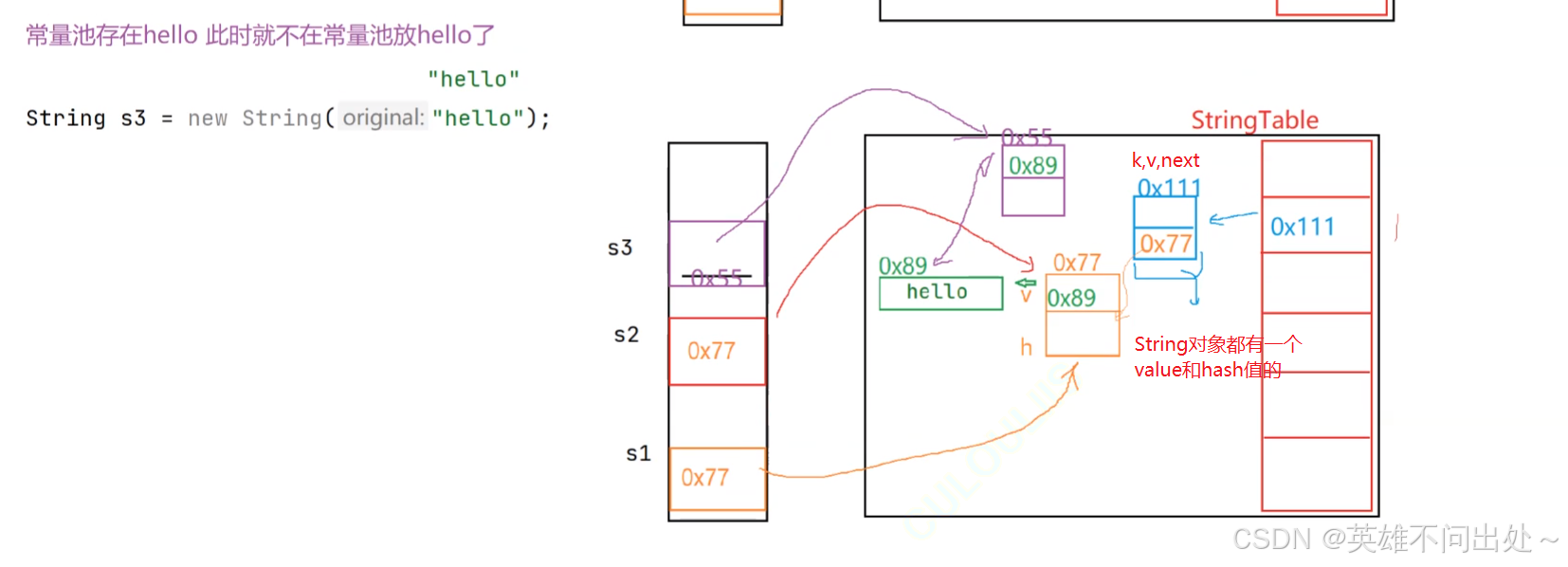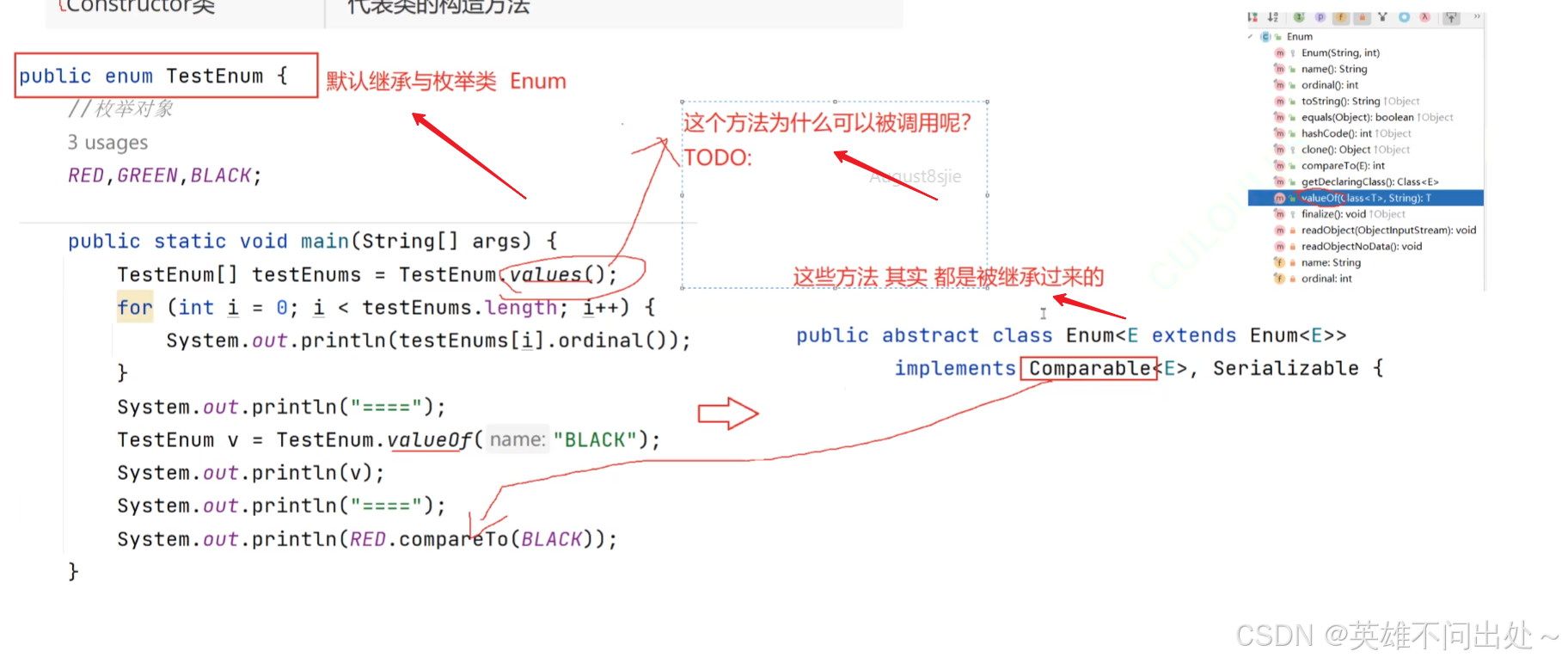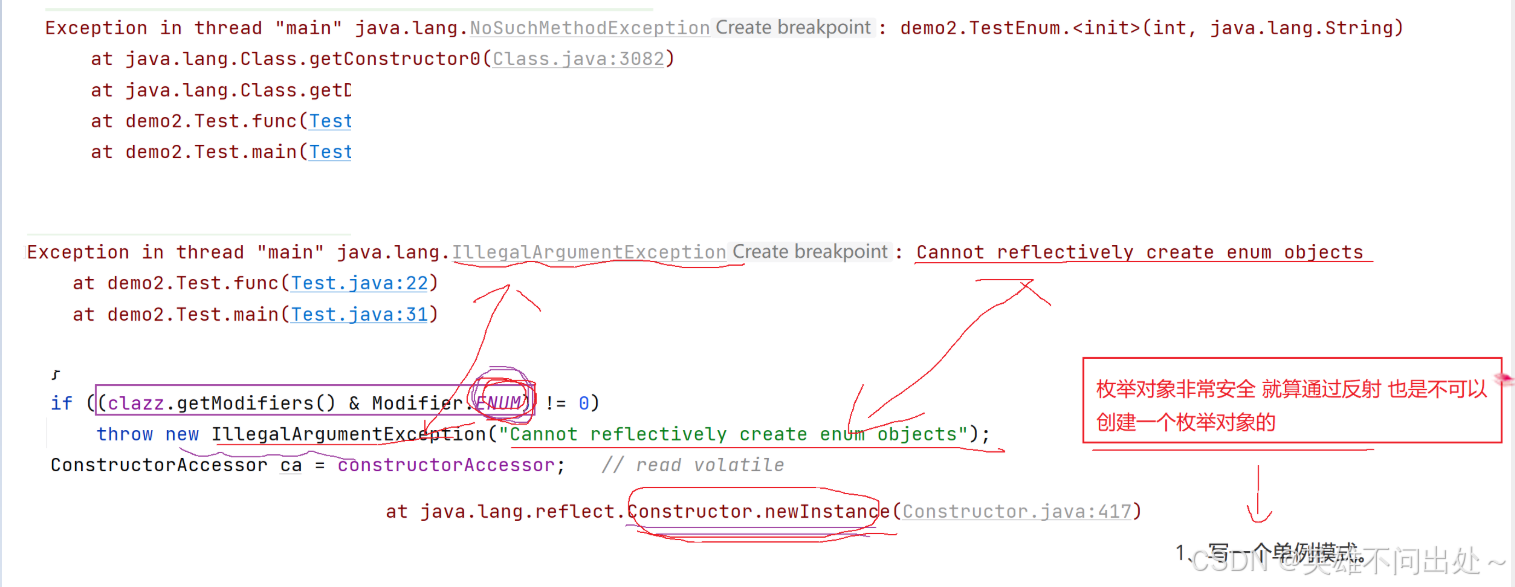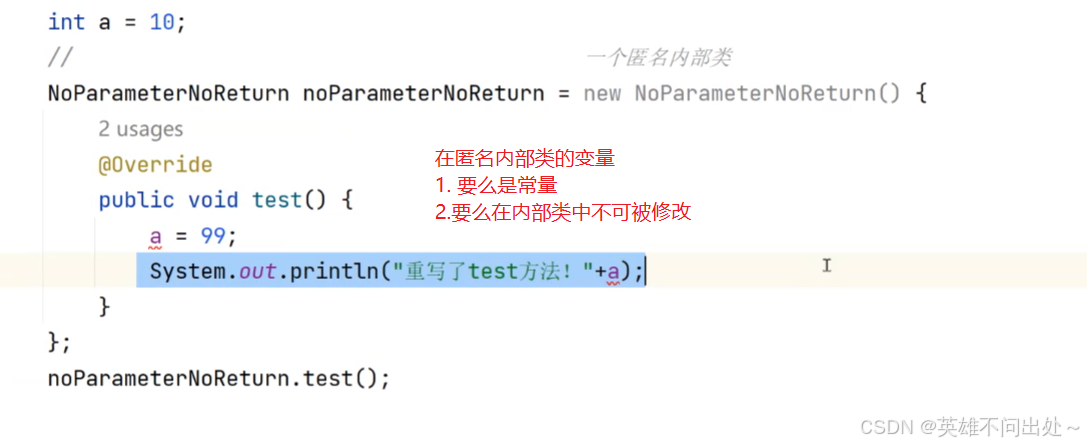文章目录
字符串常量池
- 用来存储是一个固定大小的HashTable
- 常量池在堆当中
java
public static void main(String[] args) {
String s1 = "hello";
String s2 = "hello";
String s3 = new String("hello");
String s4 = new String("hello");
System.out.println(s1 == s2);// true
System.out.println(s1 == s3);// false
System.out.println(s3 == s4);// false
}- 每次用双引号的时候都会去常量池中检查一遍是否存在字符串
- 如果常量池中有这个字符串,就不会生成直接引用,没有就会新建一个字符串
- 双引号引起的才会放入到常量池当中


java
public static void main(String[] args) {
char[] ch = new char[]{'a','b','c'};
String s1 = new String(ch);
// s1.intern();
// 让s1所指的对象入池,如果在常量池中存在就不入池
String s2 = "abc";
System.out.println(s1 == s2);// false 有s1.intern()就是true
}

反射
- 反射:在运行 状态中,对于任何一个类,都能够知道这个类的所有属性和方法
反射实例
获取class对象的三种方式
- 使用 Class.forName("类的全路径名"); 静态方法。
前提:已明确类的全路径名。 - 使用 .class 方法。
说明:仅适合在编译前就已经明确要操作的 Class - 第三种,使用类对象的 getClass() 方法
java
public static void main(String[] args) {
Class<?> c1 = null;
try {
c1 = Class.forName("Demo1.Student");
} catch (ClassNotFoundException e) {
e.printStackTrace();
}
Class<?> c2 = Student.class;
Student student = new Student();
Class<?> c3 = student.getClass();
// Class 对象只有一个
System.out.println(c1 == c2);// true
System.out.println(c2 == c3);// true
}反射的使用实例
java
package Demo1;
import java.io.File;
import java.lang.reflect.Constructor;
import java.lang.reflect.Field;
import java.lang.reflect.InvocationTargetException;
import java.lang.reflect.Method;
public class ReflectClassDemo {
// 在类外进行反射,获取Student对象中的私有成员和方法
public static void reflectNewInstance(){
// 创建一个Class对象
Class<?> classStudent = null;
try {
classStudent = Class.forName("Demo1.Student");
// 得到Class类的实例
// 获取类的实例擦成了Object类,向下转型
Student student = (Student)classStudent.newInstance();
System.out.println(student);
} catch (ClassNotFoundException e) {
e.printStackTrace();
} catch (InstantiationException e) {
throw new RuntimeException(e);
} catch (IllegalAccessException e) {
throw new RuntimeException(e);
}
}
// 反射私有的构造方法
public static void reflectPrivateConstructor(){
Class<?> classStudent = null;
try {
classStudent = Class.forName("Demo1.Student");
// 获取构造方法
Constructor<?> constructor = classStudent.getDeclaredConstructor(String.class,int.class);
// 如果是私有的构造方法确定要修改,要设置为true
constructor.setAccessible(true);
// 利用构造方法构造对象
Student student = (Student)constructor.newInstance("xiaoming",15);
System.out.println(student);
} catch (ClassNotFoundException e) {
e.printStackTrace();
} catch (NoSuchMethodException e) {
throw new RuntimeException(e);
} catch (InvocationTargetException e) {
throw new RuntimeException(e);
} catch (InstantiationException e) {
throw new RuntimeException(e);
} catch (IllegalAccessException e) {
throw new RuntimeException(e);
}
}
// 获取私有字段
public static void reflectPrivateField(){
Class<?> classStudent = null;
try {
classStudent = Class.forName("Demo1.Student");
// 获取字段
Field filed = classStudent.getDeclaredField("name");
filed.setAccessible(true);
// 获取对象
Student student = (Student)classStudent.newInstance();
// 修改该对象的字段
filed.set(student,"caocao");
System.out.println(student);
} catch (ClassNotFoundException e) {
e.printStackTrace();
} catch (NoSuchFieldException e) {
throw new RuntimeException(e);
} catch (InstantiationException e) {
throw new RuntimeException(e);
} catch (IllegalAccessException e) {
throw new RuntimeException(e);
}
}
// 获取私有的方法
public static void reflectPrivateMethod(){
Class<?> classStudent = null;
try {
classStudent = Class.forName("Demo1.Student");
// 获取私有的方法对象
Method method = classStudent.getDeclaredMethod("function",String.class);
// 设置为true可以调用私有方法
method.setAccessible(true);
// 获取student对象
Student student = (Student) classStudent.newInstance();
// 调用私有的方法
method.invoke(student,"我是一个反射的参数");
} catch (ClassNotFoundException e) {
e.printStackTrace();
} catch (NoSuchMethodException e) {
throw new RuntimeException(e);
} catch (InstantiationException e) {
throw new RuntimeException(e);
} catch (IllegalAccessException e) {
throw new RuntimeException(e);
} catch (InvocationTargetException e) {
throw new RuntimeException(e);
}
}
public static void main(String[] args) {
// reflectNewInstance();
// reflectPrivateConstructor();
// reflectPrivateField();
reflectPrivateMethod();
}
}
枚举
使用在switch语句中
java
public enum TestEnum {
RED,GREEN,BLACK;
// 使用在switch语句
public static void main1(String[] args) {
TestEnum color = RED;
switch (color){
case GREEN:
System.out.println("GREEN");
break;
case RED:
System.out.println("RED");
break;
case BLACK:
System.out.println("BLACK");
break;
default:
System.out.println("error");
break;
}
}
}枚举函数的使用
- values() 方法是编译器生成的
- values() 方法是枚举类型的隐式方法
在 Java 中,所有枚举类型(enum)都会自动生成一个 values() 静态方法,它返回该枚举的所有实例(常量)组成的数组。

java
public enum TestEnum {
RED,GREEN,BLACK;
public static void main(String[] args) {
// 以数组形式返回枚举类型的所有成员
TestEnum[] testEnums = TestEnum.values();
for(int i = 0;i < testEnums.length;i++){
// 获取枚举成员的索引位置
System.out.println(testEnums[i].ordinal());
}
System.out.println("===");
// 将普通字符串转化为枚举实例
TestEnum v = TestEnum.valueOf("BLACK");
System.out.println(v);
System.out.println("===");
// 比较他们在定义时的顺序
System.out.println(RED.compareTo(BLACK));// -2
}
}- 枚举的构造方法默认是私有的
java
public enum TestEnum {
RED(1,"红色"),
GREEN(2,"绿色"),
BLACK(3,"蓝色");
public int ordinal;
public String color;
private TestEnum(int ordinal,String color){
this.ordinal = ordinal;
this.color = color;
}
}- 枚举不能被继承,因为它的构造方法是私有的,要被继承需要重写父类的构造方法

- 枚举对象非常安全,就算通过反射也不能创建一个枚举对象的

- 枚举不能通过反射直接实例化 ,不能通过反射调用枚举的构造方法
枚举的构造方法默认是 private,即使你不写 private,编译器也会自动加上。
枚举的实例必须在枚举内部显式定义
java
package Demo2;
import java.lang.reflect.Constructor;
import java.lang.reflect.InvocationTargetException;
public class ReflectClassTestEnum {
public static void main(String[] args) throws ClassNotFoundException,
InstantiationException, IllegalAccessException, NoSuchMethodException,
InvocationTargetException {
// 获取Class类
Class<?> classTestEnum = Class.forName("Demo2.TestEnum");
// 获取枚举类的对象
Constructor<?> constructor = classTestEnum.getDeclaredConstructor
(String.class,int.class,int.class, String.class);
constructor.setAccessible(true);
TestEnum testEnum = (TestEnum) constructor.newInstance("黑色",2,1,"白色");
System.out.println(testEnum);
}
}Lambda表达式
- 函数式接口:一个接口只有一个抽象方法
实例
java
package Demo3;
import java.util.Comparator;
import java.util.Map;
import java.util.PriorityQueue;
//无返回值无参数
// @FunctionalInterface表明着是一个函数式接口
@FunctionalInterface
interface NoparameterNoReturn{
// 只能有一个抽象方法
void test();
}
//无返回值一个参数
@FunctionalInterface
interface OneParameterNoReturn {
void test(int a);
}
//无返回值多个参数
@FunctionalInterface
interface MoreParameterNoReturn {
void test(int a,int b);
}
//有返回值无参数
@FunctionalInterface
interface NoParameterReturn {
int test();
}
//有返回值一个参数
@FunctionalInterface
interface OneParameterReturn {
int test(int a);
}
//有返回值多参数
@FunctionalInterface
interface MoreParameterReturn {
int test(int a,int b);
}
public class Test {
public static void main(String[] args) {
// 有返回值
// 无参数
// NoParameterReturn noParameterReturn = ()->{return 10;};
NoParameterReturn noParameterReturn = ()->10;
System.out.println(noParameterReturn.test());
// 一个参数
// OneParameterReturn oneParameterReturn = (a)->{return a;};
OneParameterReturn oneParameterReturn = a-> 20;
System.out.println(oneParameterReturn.test(10));
// 两个参数
MoreParameterReturn moreParameterReturn = (int a,int b)->{return a + b;};
System.out.println(moreParameterReturn.test(10,20));
}
public static void main2(String[] args) {
// lambda表达式 无参数
// 无返回值
NoparameterNoReturn noparameterNoReturn = ()-> System.out.println("重写了test1()方法");
noparameterNoReturn.test();
// 1个参数
OneParameterNoReturn oneParameterNoReturn = (a)->{
System.out.println("oneParameterNoReturn " + a);
};
oneParameterNoReturn.test(10);
/*
OneParameterNoReturn oneParameterNoReturn = a->
System.out.println("oneParameterNoReturn " + a);
*/
// 可以省略类型
MoreParameterNoReturn moreParameterNoReturn = (int a,int b)->{
System.out.println(a+b);
};
moreParameterNoReturn.test(1,2);
}
public static void main1(String[] args) {
// 匿名内部类
NoparameterNoReturn noparameterNoReturn = new NoparameterNoReturn() {
@Override
public void test() {
System.out.println("重写了test1()方法");
}
};
noparameterNoReturn.test();
PriorityQueue<Integer> priorityQueue = new PriorityQueue<>(new Comparator<Integer>() {
@Override
public int compare(Integer o1, Integer o2) {
return 0;
}
});
PriorityQueue<Integer> priorityQueue1 = new PriorityQueue<>((o1,o2)->{return o1 - o2;});
}
}变量捕获
- 变量捕获:要么是常量,要么是没有被修改过的变量
匿名内部类

lambda表达式

lambda表达式在集合当中的使用
- 打印,ArrayList的forEach方法
java
public static void main(String[] args) {
ArrayList<String> list = new ArrayList<>();
list.add("hello");
list.add("world");
list.add("queue");
list.forEach(new Consumer<String>() {
@Override
public void accept(String s) {
System.out.println(s);
}
});
list.forEach(s-> System.out.println(s));
}- sort方法
java
/*list.sort(new Comparator<String>() {
@Override
public int compare(String o1, String o2) {
return o1.compareTo(o2);
}
});*/
list.sort((o1,o2)->o1.compareTo(o2));
list.forEach(s-> System.out.println(s));- map方法
java
public static void main(String[] args) {
HashMap<Integer,String> hashMap = new HashMap<>();
hashMap.put(1,"a");
hashMap.put(2,"b");
hashMap.put(3,"c");
/*hashMap.forEach(new BiConsumer<Integer, String>() {
@Override
public void accept(Integer integer, String s) {
System.out.println("Integer:"+ integer + " String:" + s);
}
});*/
hashMap.forEach((a,b)-> System.out.println("Integer:"+ a + " String:" + b));
}- lambda表达式可读性比较差,不可调试,但是比较简洁